Buxus is a living decoration of parks and gardens.
Buxus, which is very often called Boxwood, belongs to the plants of the boxwood family. Its name comes from the Greek word, which means "dense". The subtropics of Europe are considered its homeland. This plant is well distributed in Cuba, Madagascar, can be found on the Black Sea coast, also found in Mexico and Asia. The advantages of Boxwood or Buxus are that it is an evergreen shrub. Many of its species live up to 500 years. Boxwood is highly valued in the world, and many different goods and souvenirs are made from it.
Content:
- Types of axle box
- Landing and caring for the buxus
- Reproduction and medicinal properties of buxus
- Landscape design
Types of axle box
There are relatively few types of buxus, about 30. However, in decorative and home cultivation only a few have become popular.
Buxus is evergreen.
- This type of boxwood is larger than a tree than a bush, since its height can reach 15 m.
- It is the most popular evergreen of this family in Europe.
- The leaves are small and grow very densely on the shoots of the plant. They have an oblong-oval shape, bright green, dark in color, without shine.
- The arrangement of the foliage is opposite, the planting is very low.
- Boxwood blooms with small greenish flowers.
- They are of two types: pistillate flowers grow one at a time, but staminate ones gather in small inflorescences.
- The fruits of this shrub are spherical bolls.
Balearic buxus.
- This type of boxwood grows in the Balearic Islands, where the name comes from.
- You can also find it in the mountains of Morocco, Portugal and Spain.
- This type of buxus has relatively large leaves, which can reach 4 cm.
- It grows much faster than evergreen buxus, however, it does not tolerate European winters.
Small-leaved buxus.
- This shrub has small leaves, beautiful in shape and densely located on the shoots.
- It tolerates winters very well, but not harsh ones. In the cold season, the leaves remain the same green as in the spring and summer.
Buxus is Caucasian.
- This type of boxwood is found naturally in the southeast of Turkey, and on the Black Sea coast. Very rare, listed in the Red Book.
- Among all types of buxus common in Europe, it is considered the most winter-hardy.
- It can withstand frost with low temperatures, up to -10 degrees.
One of the most valuable, the Caucasian buxus has a very dense crown, it can grow up to 10 m in height, there are also specimens of 20 m in height.
- It grows slowly, but is long-lived, the age of some trees-shrubs reaches 600 years.
Landing and caring for the buxus
Buxus plant is unpretentious and hardy. It easily takes root anywhere after transplantation. A young or adult plant tolerates transplanting very well at any season from spring to autumn, inclusive.
The main condition for transplanting an adult plant is to dig it out with a large clod of earth and move it to a new place with it.
And with good care, top dressing and timely watering the plant does not stop growing. It is also recommended to mulch the plant after transplanting.
When the plant is brought to a new location and a recess is being prepared for planting, it is important not to lower the roots below the old coma growth mark.
For landing you need:
- Make it deep enough so that the ground can be trampled around the trunk. This is done so that during watering the water remains on top for some time.
- Also, when transplanting, you can add a little fertile substrate that you can prepare yourself.
- This will be very useful if the plant grew on less fertile soil or when digging out roots for transplanting, sand, loam or some kind of debris was found.
- It is very simple to prepare the substrate from materials that almost every gardener has. Compost, humus, black peat, black soil, deciduous soil, dry humus - all these can serve as ingredients and good feeding for the transplanted plant.
- Boxwood requires regular pruning, due to it, new shoots with dense foliage are formed.
- But it is also necessary during this period to fertilize the plant with mineral fertilizers with microelements.
- It is also regularly necessary to fluff the ground under the bush and remove weeds.
When a large amount of weed appears and the soil dries out, boxwood leaves will begin to turn yellow.
On the eve of the cold winter season, it is necessary to saturate the buxus with water so that the plant has enough moisture for the entire winter period. It is also good to mulch the soil around the plant with coniferous bark. The main thing is not to use foliage, because if the winter is warm, the foliage will rot and rot.
Reproduction and medicinal properties of buxus
Reproduction of buxus is a rather complicated and problematic business, but experienced gardeners will be able to cope with it. Boxwood reproduces vegetatively. In summer or autumn, grafting takes place. From 100 cuttings, up to 80 pieces can take root. Pick shoots for grafting it is necessary carefully.
They should become a little woody at the base, then there will be more chance of rooting:
- After the boxwood has taken up pretty good roots, it must be planted in loose soil with peat and cover each sprout with a jar.
- Cuttings should be watered every day and after 5 weeks they should be well rooted in the ground.
- Then the banks are removed and after a month, small cuttings may appear, which can already be transplanted into open ground.
- For the winter, such sprouts are closed and insulated, and in the spring they will already grow in all directions.
But if rooting is slow, then the cuttings can be transplanted into a tub and let them overwinter on the windowsill, and in the spring they can be planted in the ground in a permanent place.
Medicinal properties.
- Since ancient times, boxwood has been used as remedy... With the help of this plant, coughs, malaria, and intestinal diseases were treated. However, boxwood is very poisonous, so these days it is used very little due to the difficulties with the dosages of this plant. However, it can be found in homeopathic remedies for rheumatism.
Poisonous properties.
- All parts of boxwood are poisonous, but most of the toxins are contained in the foliage of this beautiful bush. It is dangerous not only for people, but also for animals, especially dogs. The foliage of boxwood contains 3% alkaloids.
Landscape design
Designers and gardeners began to use boxwood for artificial hedges, for decorating and forming a garden back in the 17th century.
It was especially fashionable in France, when multi-level gardens were made, and various bizarre shapes were carved from adult bushes. Many of these gardens were laid out near royal palaces, some of which have survived to our time. It was also very fashionable to make labyrinths from these plants.
This fashion has remained in the modern world. Boxwood can be found in flower beds near expensive restaurants or shops. Many owners of private houses make their own gardens with the obligatory use of a bucket.
Landscape designers love working with boxwood.
Its unpretentiousness and density of greenery is always advantageous. looks on any flowerbed or in the garden.It is also very easy to give it a shape, for example, from an early age, place the plant in certain frames using a grid, you can get a cone or a square, or whatever the customer wants. And mature plants are easily formed with the help of an experienced designer with garden scissors. Owners of houses, shops and restaurants are attracted by planting boxwood in a flower bed because it does not require special care.
Professionals give the plant the necessary shape, place it in the most beautiful place and, apart from watering, no additional hassle is required.
The haircut is very simple, it needs to be produced from time to time, but not as often as other similar plants of other species.
More information can be found in the video.



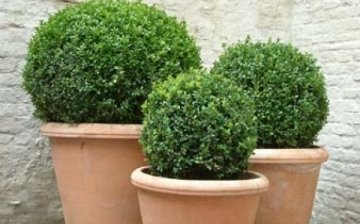
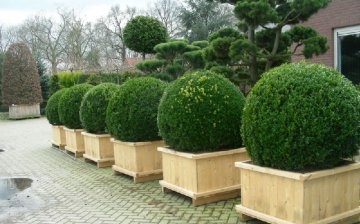

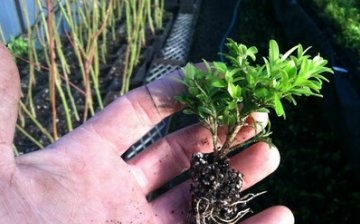
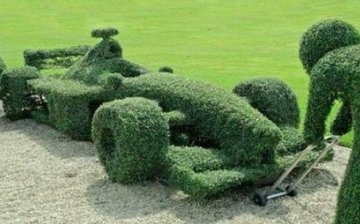





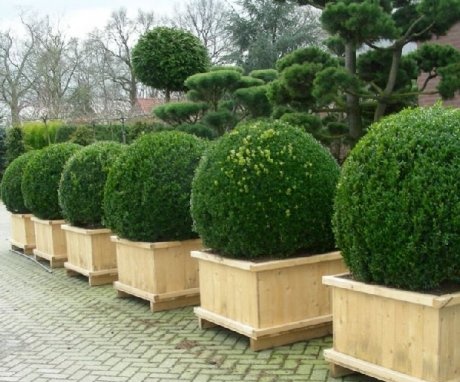
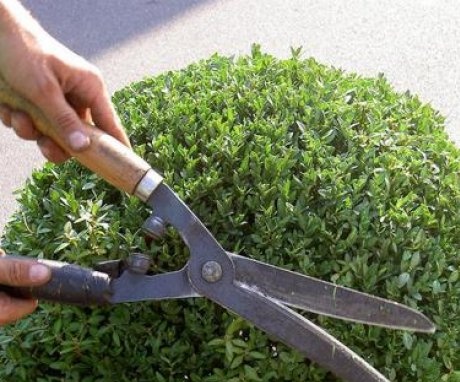


Did I understand correctly that for the winter, an adult buxus plant is not covered and carried away from the garden to a warm place?